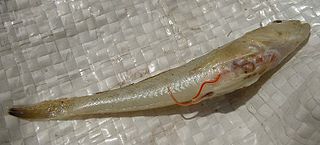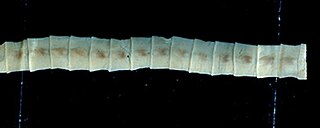Haemonchus is a genus of nematodes belonging to the family Trichostrongylidae.

Anisakis is a genus of parasitic nematodes that have life cycles involving fish and marine mammals. They are infective to humans and cause anisakiasis. People who produce immunoglobulin E in response to this parasite may subsequently have an allergic reaction, including anaphylaxis, after eating fish infected with Anisakis species.

Karl Asmund Rudolphi was a Swedish-born German naturalist, who is credited with being the "father of helminthology".

Leucochloridium is a genus of parasitic trematode worms in the order Diplostomida. It Is the sole genus in the family Leucochloridiidae. Members of this genus cause pulsating swellings in the eye-stalks of snails, so as to attract the attention of predatory birds required in the parasites' lifecycle.

The blue bird-of-paradise is a beautiful, relatively large species of bird-of-paradise. It is the only species in the genus Paradisornis, but was previously included in the genus Paradisaea.
Pareiorhina is a genus of armored catfishes native to South America where they are only found in Brazil. These species are known to occur at altitudes above 650 metres (2100 ft) in various rivers of the Grande, Paraíba do Sul, São Francisco and Tietê River basins. This genus was first erected by Gosline in 1947 as a monotypic genus to include Rhinelepis rudolphi. It was not until 2003 that a second species, P. carrancas, was described. The third species, P. brachyrhyncha was described in 2005. Pareiorhina forms a monophyletic subunit with Neoplecostomus within the subfamily Neoplecostominae.
Filaria is a genus of nematodes belonging to the family Filariidae.

The thorny-headed worm family Polymorphidae contains endoparasites which as adults feed mainly in fish and aquatic birds. When this taxon was erected by Meyer in 1931, a subfamily Polymorphinae was established in it. As the Polymorphidae as presently understood would then be monotypic, with no basal genera outside the Polymorphinae, the proposed subfamily is redundant for the time being and therefore most modern treatments simply omit it. Polymorphus minutus is an economically significant parasite in goose and duck farming.

Oligacanthorhynchida is an order containing a single parasitic worm family, Oligacanthorhynchidae, that attach themselves to the intestinal wall of terrestrial vertebrates.
Centrorhynchidae is a family of parasitic worms. Three species of these thorny-headed worms in the genus Centrorhynchus were found to parasitize birds of prey and owls Slovakia. These hosts include Buteo buteo, Buteo rufinus, Falco tinnunculus, Asio otus, Strix aluco, Strix uralensis and Tyto alba.

Litozamia is a genus of sea snails, marine gastropod mollusks in the subfamily Trophoninae of the family Muricidae, the murex snails or rock snails.

Purpura is a genus of sea snails, marine gastropod mollusks in the subfamily Rapaninae of the family Muricidae, the murex snails or rock snails.

Eustrongylides is a genus of nematodes belonging to the family Dioctophymatidae. The species of this genus cause eustrongylidosis.
Ichthyocotylurus is a genus of flatworms belonging to the family Strigeidae.
Prosthogonimus is a genus of trematodes belonging to the family Prosthogonimidae.
Mesocestoides is a genus of flatworms belonging to the family Mesocestoididae.

Bothriocephalus is a genus of flatworms belonging to the family Bothriocephalidae.
Acuaria is a genus of nematodes belonging to the family Acuariidae.
Oxyuris is a genus of nematodes belonging to the family Oxyuridae.

Triaenophorus nodulosus, the pike tapeworm, is a species of parasitic cestode (tapeworm) in the family Triaenophoridae. It is known to infect the northern pike, as well as other piscivorous fish, being found in the intestine of its host. It has been found in North America, Europe and England.









